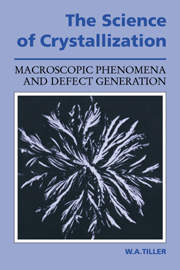Book contents
- Frontmatter
- Contents
- Preface
- Symbols
- 1 Introduction
- 2 Convection and heat transfer
- 3 Steady state solute partitioning
- 4 Macroscopic and microscopic solute redistribution
- 5 Morphological stability of interfaces
- 6 Dynamic interface morphologies
- 7 Physical defect generation during bulk crystal growth
- 8 Defect generation during thin film formation
- References
- Index
Preface
Published online by Cambridge University Press: 22 January 2010
- Frontmatter
- Contents
- Preface
- Symbols
- 1 Introduction
- 2 Convection and heat transfer
- 3 Steady state solute partitioning
- 4 Macroscopic and microscopic solute redistribution
- 5 Morphological stability of interfaces
- 6 Dynamic interface morphologies
- 7 Physical defect generation during bulk crystal growth
- 8 Defect generation during thin film formation
- References
- Index
Summary
This book first reviews the important findings described in the companion volume The science of crystallization: microscopic interfacial phenomena. It then deals specifically with convection, heat transport and solute transport to describe both steady state and transient solute distributions in bulk crystals, small crystallites of various shapes and thin films. It integrates all these factors to describe interface instability for interfaces of different shapes and predicts the dominant morphological characteristics found in crystals during either single phase or polyphase crystallization. These concepts have been extended to embrace biological crystallization and the connecting links between the morphological features of polymer crystallization and simple organic molecule crystallization.
These concepts are put to work to treat the generation of physical and chemical defects in both bulk crystals and thin films showing both the origin of these faults as well as some procedures for eliminating them.
The present book and its companion are the culmination of over 35 years of thought and personal study concerning modern-day science and technology of the crystallization process. A special perspective and a special approach have been developed for understanding the intricacies of any phase transformation in a fundamental and scientific way so that technological utilization can be readily engineered.
This pair of books differs from others available in the “crystal growth” area in that they are sufficiently broad-ranging to provide the scientific basis for understanding and treating any application area – single crystal growth, chemical crystallizers, film formation, ingots and castings, welding, frozen food processing, cryogenic organ storage, geological sleuthing, etc.
- Type
- Chapter
- Information
- The Science of CrystallizationMacroscopic Phenomena and Defect Generation, pp. xv - xviPublisher: Cambridge University PressPrint publication year: 1992

